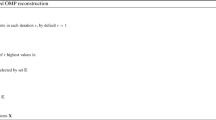Abstract
This paper proposes a generalized multipath separability condition for subspace processing and derives a novel COD (Combined Oversampling and Displacement) algorithm to utilize both spatial and temporal diversities for path separation, DOA (Direction of Arrival) estimation and signal recovery. A unique advantage lies in its ability to cope with the situation where the number of multipaths is larger than that of antenna elements, which has not been treated in the traditional approaches. COD strategy solves the antenna deficiency problem by combining vertical expansion with temporal oversampling and horizontal expansion with spatial displacement. We provide a detailed analysis on the theoretical footings for COD factorization and multipath separability conditions, which naturally leads to COD path separation and DOA estimation algorithms. Another advantage of COD factorization hinges upon its ability to generate a multiplicity of eigenvalues which greatly facilitates a SIMO channel equalization formulation useful for signal recovery. This paper also proposes a frequency-domain total-least-square algorithm for SIMO equalization procedure. Finally, simulation results on path separation, DOA estimation and signal recovery are demonstrated.
Similar content being viewed by others
References
R. Kohno, “Spatial and Temporal Communication Theory Using Adaptive Antenna Array,” IEEE Personal Communications, vol. 5,no. 1, 1998, pp. 28-35.
R.O. Schmidt, “Multiple Emitter Location and Signal Parameter Estimation,” IEEE Transactions on Antennas and Propagation, vol. AP-34,no. 3, 1986.
S.Y. Kung, K.S. Arun, and B. Rao, “State Space and Singular Value Decomposition Based on Approximation Methods for Harmonic Retrieval,” Journal of the Optical Society of America, Dec. 1983, pp. 1799-1811.
R. Roy and T. Kailath, “ESPRIT-Estimation of Signal Parameters via Rotational Invariance Techniques,” IEEE Transactions on ASSP, vol. 37,no. 7, 1986, pp. 984-995.
A.J. Paulraj and C.B. Papadias, “Space-Time Processing for Wireless Communications,” IEEE Signal Processing Magazine, vol. 14,no. 5, 1997, pp. 49-83.
H. Krim and M. Viberg, “Two Decades of Array Signal Processing Research,” IEEE Signal Processing Magazine, vol. 13,no. 4, July 1996, pp. 67-94.
L. Tong, G. Xu, and T. Kailath, “Blind Identification and Equalization Based on Second-order Statistics: A Time Domain Approach,” IEEE Transactions on Information Theory, vol. 40, 1994, pp. 340-349.
A.J. van der Veen, S. Talwar, and A. Paulraj, “A Subspace Approach to Blind Space-time Signal Processing for Wireless Communication Systems,” IEEE Transactions on Signal Processing, vol. 43, 1995, pp. 2982-2993.
G.B. Giannakis, Y. Hua, P. Stoica, and L. Tong, Signal Processing Advances in Wireless and Mobile Communications: Trends in Channel Estimation and Equalization, Prentice Hall, NJ, 2000, Upper Saddle River, NJ 07458.
P. Stoica and A. Nehorai, “MUSIC, Maximum Likelihood, and Cramer-Rao Bound,” IEEE Transactions on Acoustics, Speech, and Signal Processing, vol. 37,no. 5, 1989, pp. 720-741.
R.L. Johnson, “Eigenvector Matrix Partition and Radio Direction Finding Performance,” IEEE Transactions on Antenna and Propagation, vol. AP-34,no. 8, 1986, pp. 985-991.
A.J. van der Veen, “Algebraic Method for Deterministic Blind Beamforming,” Proceeding of the IEEE, vol. 86,no. 10, 1998, pp. 1987-2008.
M. Kristensson, D.T.M. Slock, and B. Ottersten, “Blind Subspace Identification of a BPSK Communication Channel,” Proceedings of the 30th Asilomar Conference on Signals, Systems and Computers, Pacific Grove, CA, vol. 2, Nov. 1996, pp. 828-832.
E. Moulines, J.F. Cardoso, A. Gorokhov, and P. Loubaton, “Subspace Methods for Blind Identification of SIMO-FIR Systems,” in International Conference on Acoustics, Speech, and Signal Processing (ICASSP), Atlanta, Georgia, May 1996, vol. 5, pp. 2449-2952.
E. Moulines, P. Duhamel, J.F. Cardoso, and S. Mayrargue, “Subspace Methods for the Blind Identification of Multichannel FIR Filters,” IEEE Transactions on Signal Processing, vol. 43,no. 2, April 1995, pp. 516-525.
V.U. Reddy, C.B. Papadias, and A.J. Paulraj, “Second-order Blind Identifiability of Certain Classes of Multipath Channels Using Antenna Arrays,” in International Conference on Acoustics, Speech, and Signal Processing (ICASSP), Munich, Germany, April 1997, vol. 5, pp. 3465-3468.
H. Zeng and L. Tang, “Blind Channel Estimation Using the Second-order Statistics: Algorithms,” IEEE Transactions on Signal Processing, vol. 45,no. 8, 1997, pp. 1919-1930.
L. Tong and S. Perreau, “Multichannel Blind Identification: from Subspace to Maximum Likelihood Methods,” in Proceeding of the IEEE, vol. 86,no. 10, 1998, pp. 1951-1968.
G. Xu, H. Liu, L. Tong, and T. Kailath, “A Least-Squares Approach to Blind Channel Identification,” IEEE Transactions on Signal Processing, vol. 43, Dec. 1995, pp. 2982-2993.
L. Tong, G. Xu, and T. Kailath, “A New Approach to Blind Identification and Equalization of Multipath Channels,” in Proceedings of the 25th Asilomar Conference on Signals, Systems and Computers, Pacific Grove, CA, Nov. 1991, pp. 856-860.
A.J. van der Veen and A. Paulraj, “Singular Value Analysis of Space-time Equalization in the GSM Mobile System,” in International Conference on Acoustics, Speech, and Signal Processing (ICASSP), Atlanta, Georgia, USA, May 1996, vol. 2, pp. 1073-1076.
Y. Hua, “Maximum Likelihood for Blind Identification of Multiple FIR Channels,” IEEE Transactions on Signal Processing, vol. 44, 1996, pp. 756-759.
Y. Hua and M. Wax, “Strict Identifiability of Multiple FIR Channels Driven by an Unknown Arbitrary Sequence,” IEEE Transactions on Signal Processing, vol. 44, 1996, pp. 661-672.
Author information
Authors and Affiliations
Rights and permissions
About this article
Cite this article
Zhang, X., Kung, SY. COD: Diversity-Adaptive Subspace Processing for Multipath Separation and Signal Recovery. The Journal of VLSI Signal Processing-Systems for Signal, Image, and Video Technology 30, 235–256 (2002). https://doi.org/10.1023/A:1014011328534
Published:
Issue Date:
DOI: https://doi.org/10.1023/A:1014011328534




